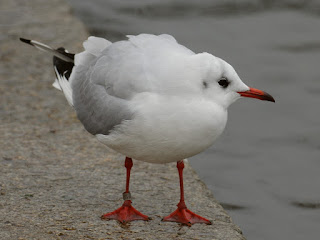The patch of wood chippings under the plane trees near Physical Energy had attracted a couple of Mistle Thrushes, which were poking around and evidently finding insects or worms.
Last year some visiting Redwings also liked wood chippings. It seems odd that such a sterile material should have so many creatures in it. The plan behind these patches was first to remove the grass under the trees, then put down a layer of topsoil in the hope that its nutrients would leach down to the tree roots, and finally to cover the layer with chippings to discourage the growth of weeds. Whether it has helped to nourish the trees is debatable, but this is the patch that has had six kinds of fungus on it, and that can't be doing the trees any good.
There were also a lot of Mistle Thrushes in the rowan trees on Buck Hill, along with Blackbirds, a Chaffinch, a Magpie, and a flock of Starlings of which this is one.
The usual mob of pigeons -- or, as a proper ornithologist would call them, Feral Rock Doves -- were wandering around near Peter Pan. It was raining quite hard at the time, and it was noticeable that the pigeons with fancy plumage, such as this speckled one, were looking much more bedraggled that the standard grey ones. It seems that the colour change has made them less waterproof.
The rain had driven people inside at the Dell restaurant, so the local Grey Heron was having to fish for its living. Fish shelter under a mat of dead leaves, so it was in the right place, but I didn't see it catch anything.
Fish also shelter under the platform of Bluebird Boats, and this is a popular hunting ground for Great Crested Grebes. You seldom see them catch a fish, because they surface under the platform to eat it without being annoyed by gulls trying to steal their catch.
The Teal was in the usual place near the Italian Gardens, poking around in the mixture of duckweed and debris. His adult plumage is developing visibly each day. You can see the white line forming on his head, dividing the green areas from the ginger ones.
The Black Swan was having an unusually peaceful day with few Mute Swans about, and was stepping out with his girlfriend on the south shore of the Serpentine.
A Common Gull on the Lido railing stared at me. You can hardly see its eyes from straight ahead, and it can't have much binocular vision. However, the eyes of most birds are so close together that binocular vision is not very useful, and they judge distance and depth by observing parallax as they move.
Owls, with forward-facing eyes, do use binocular vision, but smaller owls supplement it by moving their heads from side to side. You sometimes see our Little Owls doing this. The nasty weather today kept the Little Owls inside their hollow trees and I didn't get a glimpse of them.
I met Alan Gibson, who records the rings on Black-Headed Gulls in the London parks. He had had a very poor day with only two rings seen. We were walking towards the Vista and I said, 'I bet EY09813's there.' And so it was, and flew over immediately and landed in front of my feet to be fed.
So the gull got a whole digestive biscuit, a small piece at a time, and Alan got another number.









I *think* that as bark chippings rot down, they take nutrients out of the soil. But fungus (apart from honey fungus) is not to my knowledge damaging to trees. Please correct me anyone, as I am not sure about this.
ReplyDeleteThere are quite a few fungi that cause 'white rot' in trees. I think they are all bracket fungi, which haven't been seen -- yet -- in this place. I go past it every day and am keeping an eye on it.
DeleteAs regards 'proper' ornithologists, some years ago the British Ornithologists' Union decided to rename Rock and Stock Doves as Rock and Stock Pigeon. It's just not caught on, except in America where they say Rock Pigeon, but their ornithologists' union once considered a change to Rock Dove to be more like the British. Just to be confusing. Jim n.L.
ReplyDeleteA dove house fill’d with doves and pigeons
DeleteShudders Hell thro’ all its regions.
--- William Blake
The relationship between trees and fungi is complex; sometimes a 'mycorrhiza' forms, a symbiotic link between plant root and fungus. Some mushroom buffs think that the one between larch trees and Larch Bolete (Suillus grevillei) has been going on so long that larches now cannot survive/reproduce without the presence of the mushroom. So the links aren't always harmful – though of course they can be! I did once lose an almond tree to Honey Fungus (Armillaria mellea); and had a small revenge by making soup out of the assassin. (Beef stock, shallots, a little garlic.)
ReplyDeleteHarry G.
Thanks for the information.
DeleteHi Ralph
ReplyDeletethanks for the blog which I have just discovered - very informative and enjoyable. In case it is of interest, last week there were eight rose-ringed parakeets feeding on the fruit from a crab apple tree on the north side of Hyde Park between Lancaster Gate and Marble Arch.
Thanks -- replied to on the post for 25 November.
Delete